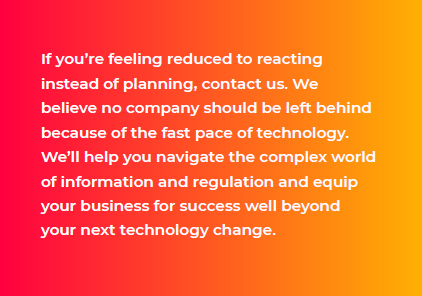In today’s transparent, user-centric world, customers also know they have other choices about who they deal with and how they can benefit from the latest and greatest applications. If you’re not willing to put them first when it comes to investing in your business, don’t be surprised when you’re not their first choice for much longer. |
Business owners and clients alike know the advantages of new technology — we experience its benefits every day in both our personal and professional lives. Despite all the advantages innovation brings, many people are intimidated by what it takes to implement new software and systems because it seems like an endless cycle once the initial IT investment is made. Jumping on the technology bandwagon without clearly identified outcomes is risky at best, but ignoring it isn’t an option for today’s business owners either.
Like it or not, out-of-date technology sends a larger message: not just that your company is behind the times, but that you’re also not willing to prioritize customers with your IT spend. Savvy clients know new technology can make things easier on them and failing to put money behind this speaks volumes about your priorities.
Bridging the Gap Between Leadership and Technology
Sometimes, the reason technology isn’t prioritized starts at the top. A lack of understanding about how new software and systems help your organization can reflect poorly on your leadership, who will be expected to leverage it to maintain competitive advantage (or, in some cases, simply keep up with others in the industry).
To outsiders, resistance to change, technological or otherwise, can signal internal dysfunction in other areas of the organization – for example, a leadership gap if management is unable to pave the way for staff, a lack of internal adaptability, or a refusal to acknowledge current marketplace conditions. None of this bode well for positioning your company favorably compared to your competitors and can also cast doubt on your ability to thrive in the future in a day and age where nearly every company is expected to be a technology company.
How to Evaluate Technology
Of course, simply throwing dollars at technology without prioritizing the spend or clearly articulating how and when customers will see improvements is just as useless — businesses need to speak to the advantages offered by new investments and translate that into customer value early and often. |
If you’re struggling to begin evaluating the potential of new technology, your own technology vendors can make a great case study for incorporating new systems in your business. However, being forced into a new system just because it’s what’s next for your current software provider doesn’t help you unlock any new potential for dealing with clients.
And with the extra time and headaches that often accompany implementations, you want to be solid in your understanding of exactly what advantages are offered. The bottom line? You should clearly see the connection between the new features offered and how they will translate into value for your clients and staff.
Increasingly, information has become a priority in today’s world, and the amount of personal data available to consumers today sets the tone for client expectations when they interact with your business. If you’re not asking new or different questions from your clients today than you were even five years ago, consider yourself behind the curve.
Furthermore, if you’re not constantly speaking to what the new information available from your current systems means to them, or providing new insights based on what you’re seeing, you may be closer to commoditization than you think. Businesses who leverage new technology to become closer to the “trusted advisor” status with their clients have the advantage today and need to ensure that relevant data insights are a part of any new technology spend.
Staying up-to-date on current technology is a competency that requires significant time and effort, and most of our clients just want to spend their time getting better at what they do. That’s why we focus on advising them on not just where to invest their technology dollars, but also when and how to spend them.
At Synoptek, we have developed deep competencies in the technologies common to our customers and continually strive to help them achieve business benefits that go beyond new features and functions. Business applications rarely operate in a vacuum and must be considered despite their own context.
For companies to win, any investment in new technology must also be accompanied by a thorough IT evaluation of not only the proposed new system but also the applications and processes surrounding it. People both inside and outside the organization need to understand why the newer version will be better, and how their daily work and interactions will be affected as a result of it.
The complexities of “upping the stack” warrant significant discussion around how any new data available can and should be used for providing better customer value, as well as how it must be protected and what rights you and your customers have after a new system is implemented.
This includes how businesses are affected by regulations such as GDPR, HIPPA, and others. We help our clients structure their technology infrastructure to compliance, configure systems so they work to their advantage and advise on what pitfalls to avoid in the process of connecting applications.
During the process of selecting new technology, it’s important to evaluate potential vendors, prepare your staff and clients for leveraging application changes and ensure your company is best positioned for long-term success.
At Synoptek, we understand the frustrations and overwhelm as technology changes at lightning speed. That’s why we can help you go beyond a successful single implementation and transform your company into one where technology is leveraged to position you as a market leader, known for being progressive in a customer-centric approach. This kind of reputation can help you attract new and different talents, work with bigger and better clients, and truly revolutionize your current processes and procedures.
Download PDF
About the Author
Tim Britt is founder and CEO of Synoptek, a Global Systems Integrator (SI) and Managed IT Services Provider (MSP) offering Comprehensive IT Management and Consultancy Services to organizations worldwide. An entrepreneur at heart — Tim leverages technology to squash the status quo and create solutions for his clients — a mission he’s been on for more than 20 years.

